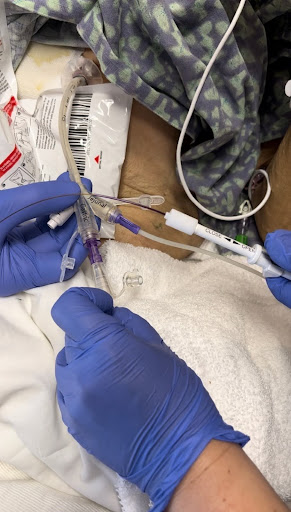Monday Poster Session
Category: General Endoscopy
P3006 - From Salivary Ducts to Feeding Tubes: A Novel Use of Sialendoscopy Tools for Enteral Tube Unclogging
Monday, October 27, 2025
10:30 AM - 4:00 PM PDT
Location: Exhibit Hall

Mark A. Mandak, MD
Medical University of South Carolina
Charleston, SC
Presenting Author(s)
Mark A. Mandak, MD1, Andrew Franklin, BS2, Ryan Beyer, MD1, Alexandra Kejner, MD1
1Medical University of South Carolina, Charleston, SC; 2University of Tennessee Health Science Center, Memphis, TN
Introduction: Enteral feeding tubes are critical in providing nutrition and medication for patients unable to meet daily caloric requirements or face significant risks with oral administration. Mechanical issues like tube impaction can hinder patient care, reducing caloric intake and leading to a decline in functional status. This case proposes the novel use of sialendoscopy tools to disimpact enteral feeding tubes refractory to routine interventions.
Case Description/
Methods: A 78-year-old male presented with concern for surgical site infection following total laryngopharyngectomy with free flap reconstruction and PEG tube placement for hypopharyngeal squamous cell carcinoma. CTA neck showed a new 2.2 cm gas and fluid collection along the superficial graft. He underwent surgical exploration, received a 2-week antibiotic course, and required multiple further debridements. Due to wound dehiscence and reflux complicating his healing process, his G-tube was revised to a G-J tube.
His hospital course was further complicated by severe impaction of both the G-limb and J-limb of his G-J tube refractory to warm water, Coca-Cola, and pancreatic enzyme solution. Interventional radiology declined tube exchange due to multiple previous revisions for clogging, and GI was precluded from safe endoscopic access in the setting of altered pharyngeal anatomy. Through adaptive problem solving, the team utilized sialendoscopy tools to extract the impacted debris with use of two tipless salivary stone extractors, a salivary duct balloon catheter, and a salivary stone micro-burr drill. Once opened, Coca-Cola was instilled into the tubes and left overnight. The next morning the G-J flushed appropriately, allowing for continuation of appropriate care.
Discussion: While interventions such as warm water flushes, Coca-Cola, and pancreatic enzyme solutions are inexpensive methods to unclog feeding tubes, they are often ineffective for severe impactions. Proper education on medication and nutritional administration, along with optimal tube care, is essential in preventing obstructions. Unfortunately, mechanical devices dedicated for the purpose of unclogging feeding tubes are not widely available, leaving procedural tube revision as a last resort. This case highlights an innovative and accessible approach to resolving refractory feeding tube impaction, allowing for optimal resource utilization and limiting the risks of operative tube replacement.

Figure: Tipless salivary stone extractor removing debris from G/J tube

Figure: Salivary duct balloon catheter stenting through G/J tube impaction
Disclosures:
Mark Mandak indicated no relevant financial relationships.
Andrew Franklin indicated no relevant financial relationships.
Ryan Beyer indicated no relevant financial relationships.
Alexandra Kejner indicated no relevant financial relationships.
Mark A. Mandak, MD1, Andrew Franklin, BS2, Ryan Beyer, MD1, Alexandra Kejner, MD1. P3006 - From Salivary Ducts to Feeding Tubes: A Novel Use of Sialendoscopy Tools for Enteral Tube Unclogging, ACG 2025 Annual Scientific Meeting Abstracts. Phoenix, AZ: American College of Gastroenterology.
1Medical University of South Carolina, Charleston, SC; 2University of Tennessee Health Science Center, Memphis, TN
Introduction: Enteral feeding tubes are critical in providing nutrition and medication for patients unable to meet daily caloric requirements or face significant risks with oral administration. Mechanical issues like tube impaction can hinder patient care, reducing caloric intake and leading to a decline in functional status. This case proposes the novel use of sialendoscopy tools to disimpact enteral feeding tubes refractory to routine interventions.
Case Description/
Methods: A 78-year-old male presented with concern for surgical site infection following total laryngopharyngectomy with free flap reconstruction and PEG tube placement for hypopharyngeal squamous cell carcinoma. CTA neck showed a new 2.2 cm gas and fluid collection along the superficial graft. He underwent surgical exploration, received a 2-week antibiotic course, and required multiple further debridements. Due to wound dehiscence and reflux complicating his healing process, his G-tube was revised to a G-J tube.
His hospital course was further complicated by severe impaction of both the G-limb and J-limb of his G-J tube refractory to warm water, Coca-Cola, and pancreatic enzyme solution. Interventional radiology declined tube exchange due to multiple previous revisions for clogging, and GI was precluded from safe endoscopic access in the setting of altered pharyngeal anatomy. Through adaptive problem solving, the team utilized sialendoscopy tools to extract the impacted debris with use of two tipless salivary stone extractors, a salivary duct balloon catheter, and a salivary stone micro-burr drill. Once opened, Coca-Cola was instilled into the tubes and left overnight. The next morning the G-J flushed appropriately, allowing for continuation of appropriate care.
Discussion: While interventions such as warm water flushes, Coca-Cola, and pancreatic enzyme solutions are inexpensive methods to unclog feeding tubes, they are often ineffective for severe impactions. Proper education on medication and nutritional administration, along with optimal tube care, is essential in preventing obstructions. Unfortunately, mechanical devices dedicated for the purpose of unclogging feeding tubes are not widely available, leaving procedural tube revision as a last resort. This case highlights an innovative and accessible approach to resolving refractory feeding tube impaction, allowing for optimal resource utilization and limiting the risks of operative tube replacement.

Figure: Tipless salivary stone extractor removing debris from G/J tube

Figure: Salivary duct balloon catheter stenting through G/J tube impaction
Disclosures:
Mark Mandak indicated no relevant financial relationships.
Andrew Franklin indicated no relevant financial relationships.
Ryan Beyer indicated no relevant financial relationships.
Alexandra Kejner indicated no relevant financial relationships.
Mark A. Mandak, MD1, Andrew Franklin, BS2, Ryan Beyer, MD1, Alexandra Kejner, MD1. P3006 - From Salivary Ducts to Feeding Tubes: A Novel Use of Sialendoscopy Tools for Enteral Tube Unclogging, ACG 2025 Annual Scientific Meeting Abstracts. Phoenix, AZ: American College of Gastroenterology.

